Not too long ago, social media wasn’t part of anyone’s daily life.
People relied on emails, phone calls, or face-to-face conversations to stay connected. There were no apps to scroll through in waiting rooms or notifications popping up every few minutes.
But everything changed fast.
Today, over 5.2 billion people around the world use social media—that’s more than 63% of the global population. It’s become the place where people talk, shop, learn, and get their news.
The following top social media platforms stats will reveal who’s leading, where, and why it matters.
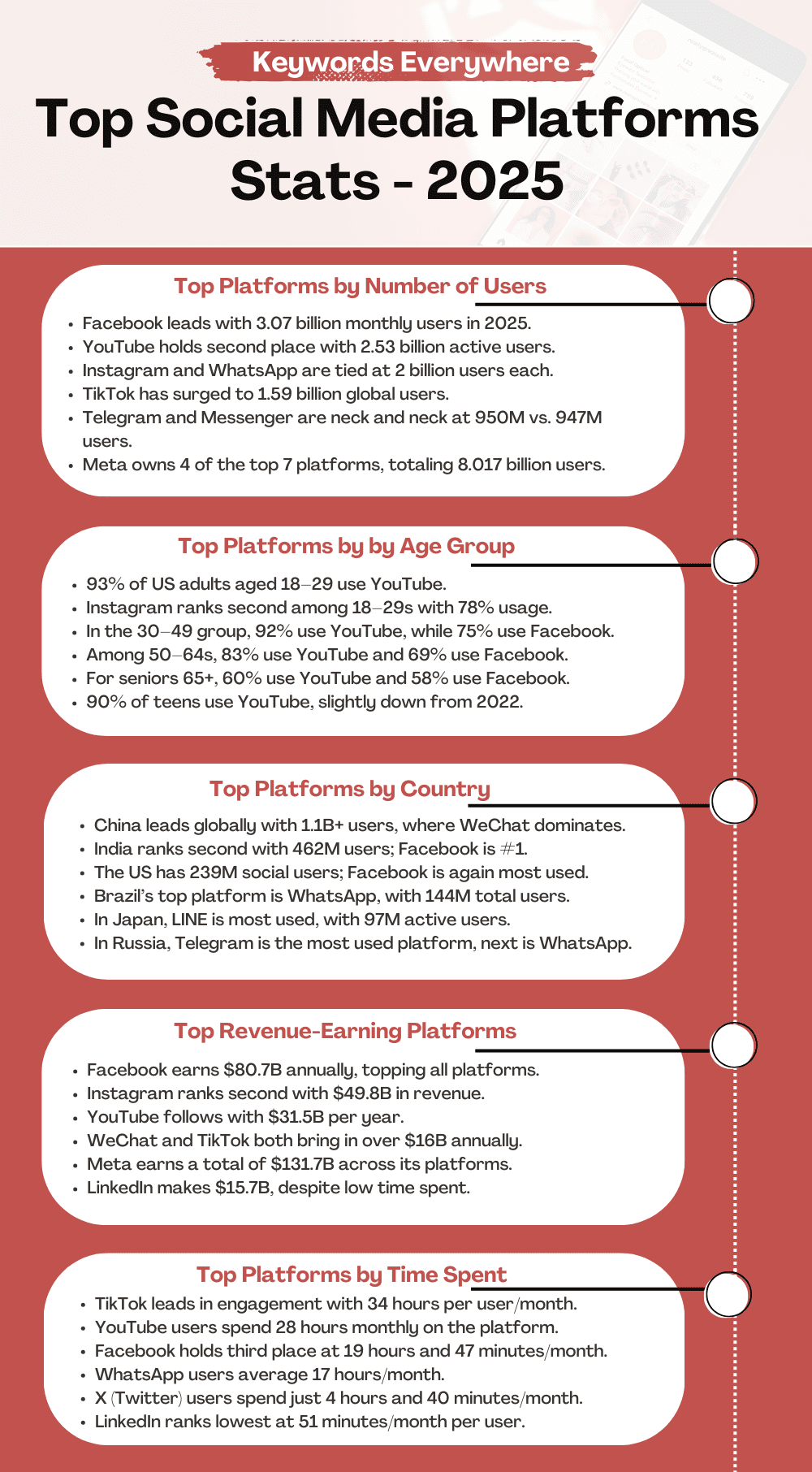
Top Social Media Platforms By Number of Users
We all know that social media runs the world these days, but some big platforms are clearly leading the pack.
From messaging apps to photo-sharing giants, user count plays a huge role in who holds the most influence.
Whether you’re marketing, networking, or just curious, knowing which platforms dominate in user base tells you where the world is hanging out.
Here are the top social media platforms stats that will reveal who’s winning in numbers.
1. In 2025, Facebook is still the top social media platform with 3.07 billion monthly active users, making it the only one to surpass 3 billion users.
2. YouTube comes in second with 2.53 billion active users, which is 540 million less than Facebook.
3. Instagram and WhatsApp both have 2 billion monthly active users, tying for third place.
4. TikTok continues to grow fast with 1.59 billion active users, just behind Instagram and WhatsApp.
5. WeChat is massive in China with 1.38 billion users, though it remains more regionally popular than globally dominant.
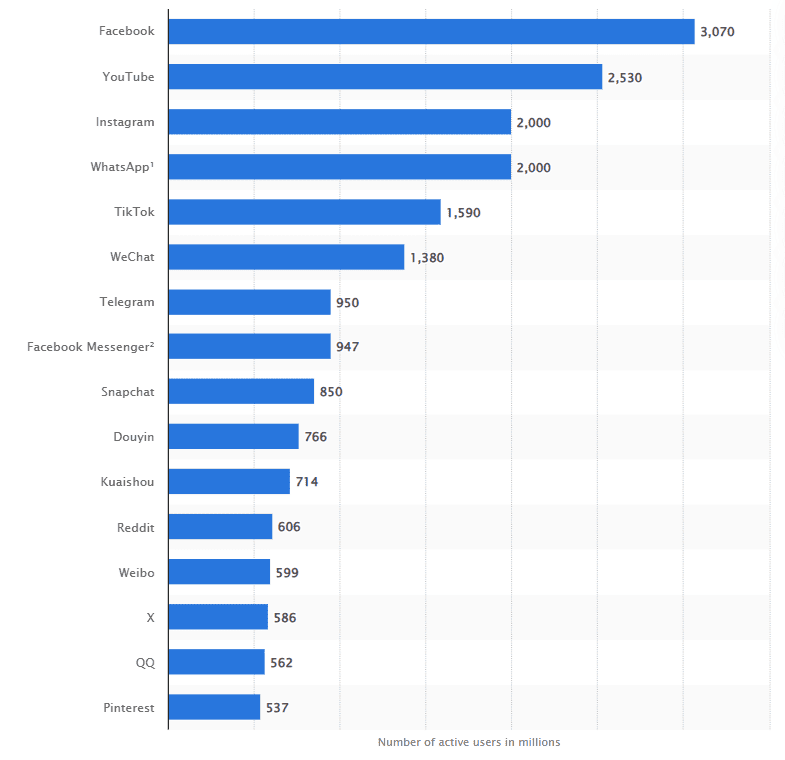
Top social media platforms by number of users 2025
6. Telegram has 950 million active users, slightly ahead of Facebook Messenger, which has 947 million users.
7. Snapchat holds strong with 850 million users, keeping its place as a favorite among younger audiences.
8. Douyin, the Chinese version of TikTok, has 766 million users in China alone, while Kuaishou isn’t far behind with 714 million users.
9. Reddit has grown to 606 million active users, showing the strength of community-driven content.
10. Weibo is another Chinese platform that has 599 million users, staying relevant in China’s social space.
11. X (formerly Twitter) now has 586 million active users worldwide, slightly trailing behind Reddit and Weibo.
12. QQ, once China’s leading chat app, still holds 562 million users, mostly in mainland China.
13. Pinterest continues to thrive with 537 million users, carving out a niche for discovery and inspiration.
14. Meta (which includes Facebook, Instagram, WhatsApp, and Messenger) controls four of the top seven platforms, showing its huge dominance with a combined 8.017 billion active users.
15. Chinese platforms like WeChat, Douyin, Kuaishou, Weibo, and QQ together have over 3.99 billion users, proving the massive scale of China’s social media ecosystem.
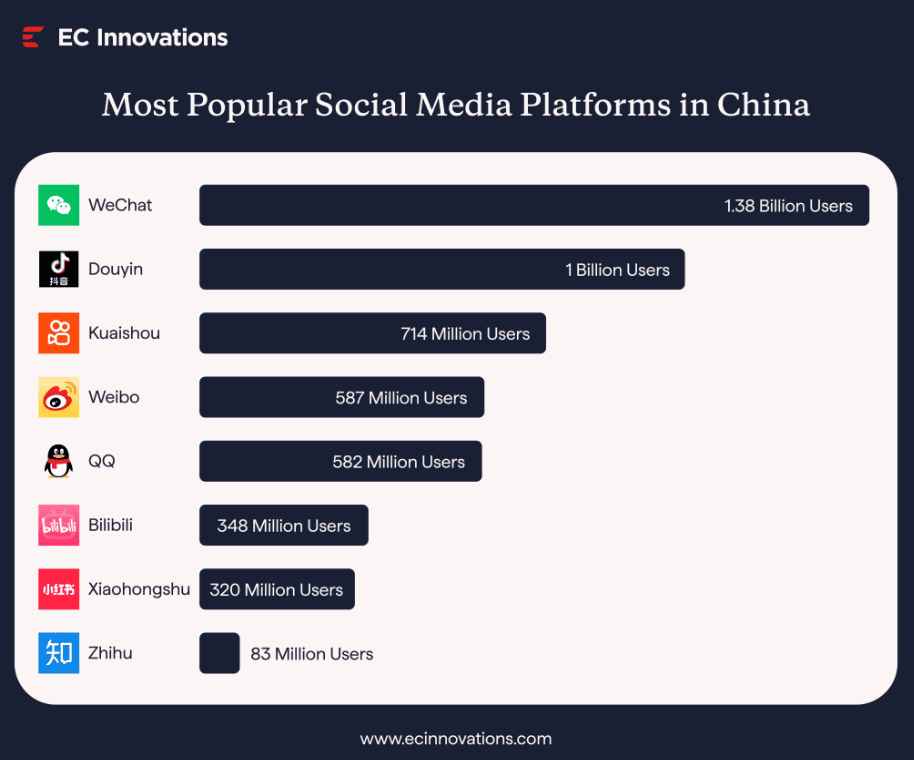
Most popular social media platforms in China
Top Social Media Platforms By Age Group
Not every app is for everyone.
Teens flock to certain platforms like TikTok and Snapchat, while older generations prefer something more familiar and easy to use, like Facebook and YouTube.
Age plays a big role in which social media platform someone chooses, and understanding that can be powerful if you’re trying to reach the right crowd.
The following top social media platforms stats will reveal how different age groups are shaping the digital space.
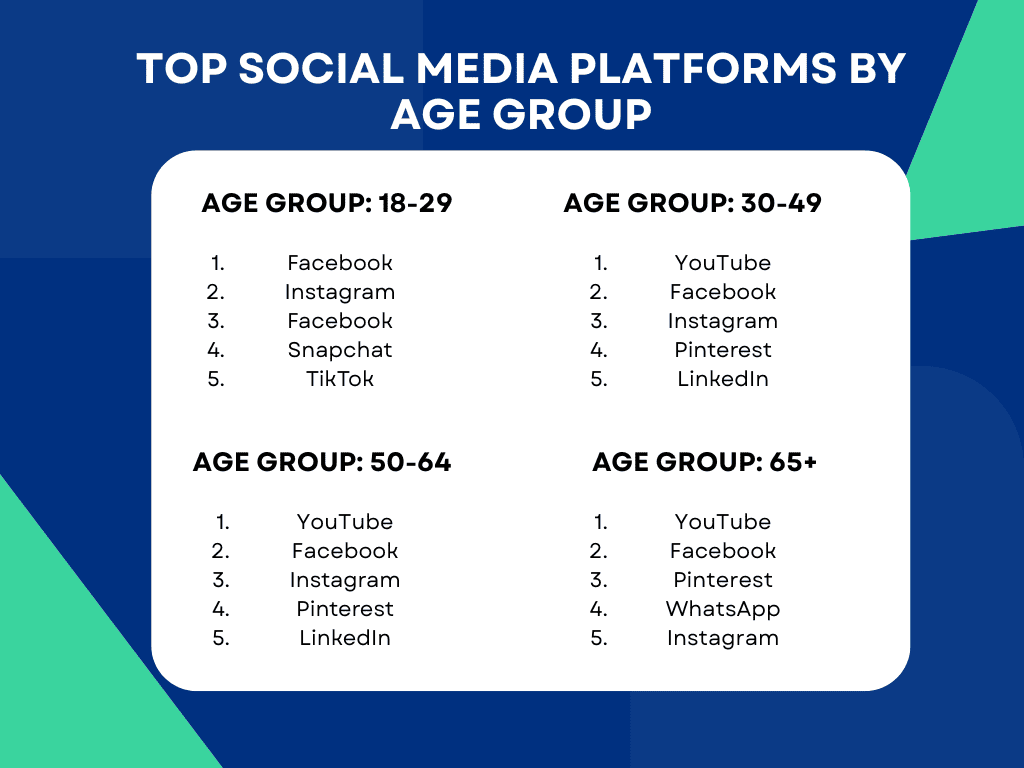
Top social media platforms by age group: 18 to 29
16. Among US adults aged 18 to 29, 93% use YouTube, making it the most-used platform for this age group.
17. Instagram is the second most popular among 18 to 29-year-olds, with 78% saying they use it regularly.
18. Facebook still holds strong in third place with 67% of young adults using the platform.
19. Snapchat is close behind, used by 65% of people in this age group.
20. TikTok rounds out the top five with 62% usage among adults aged 18 to 29 in the US.
Top social media platforms by age group: 30 to 49
21. In the 30 to 49 age group, YouTube leads with 92% of US adults using the platform.
22. Facebook comes next, used by 75% of adults in this group.
23. Instagram ranks third with 59% usage among those aged 30 to 49.
24. Pinterest and LinkedIn are tied for fourth place, each with 40% of users in this age range.
Top social media platforms by age group: 50 to 64
25. YouTube is the most-used platform for this age group, with 83% saying they use it.
26. Facebook ranks second in this group with 69% usage.
27. Instagram comes in third, used by 35% of people aged 50 to 64.
28. Pinterest follows closely with 33%, slightly ahead of LinkedIn, which is used by 31% in this age group.
Top social media platforms by age group: 65+
29. For adults aged 65 and older, YouTube remains on top with 60% usage.
30. Facebook is a close second, used by 58% of seniors in the US.
31. Pinterest comes in third with 21%, followed by WhatsApp at 16%.
32. Instagram is also used by 15% of this older age group, showing moderate adoption among seniors.
Top social media platforms by age group: Teenagers
33. YouTube is the most-used platform among US teens, with 90% saying they use it—slightly down from 95% in 2022.
34. TikTok and Instagram are tied, each used by approximately 60% of teens, showing strong ongoing popularity.
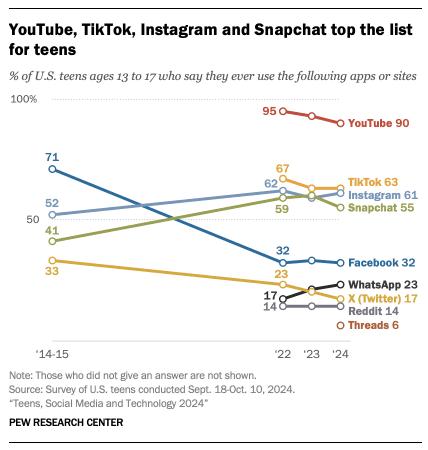
Top social media platforms used by teenagers
35. Snapchat is also widely used, with 55% of US teens saying they use the platform.
36. Facebook use among teens continues to drop, with only 32% reporting usage—down sharply from 71% in 2014–15.
37. X (formerly Twitter) is now used by just 17% of teens, a major decline from 33% a decade ago and 23% in 2022.
38. WhatsApp usage among teens is rising, with 23% saying they use it, up 6 points from 2022.
39. Reddit is used by 14% of teens, a figure that has remained mostly stable in recent years.
40. Threads, launched in 2023 by Meta, is still new among teens, with only 6% reporting usage so far.
Top Social Media Platforms By Country
Different countries have different favorites.
While one app rules the U.S., another might dominate in India or Brazil. Local culture, government policies, and language all affect which platforms people use most.
The following top social media platforms stats will reveal what the world prefers in different corners of the map.
41. China has the largest number of social media users worldwide in the world, with over 1.1 billion active users. WeChat is the most popular platform there, followed by QQ.
42. India has more than 462 million social media users, making it the second-largest market globally. Facebook is the most popular platform, with over 369.9 million monthly active users.
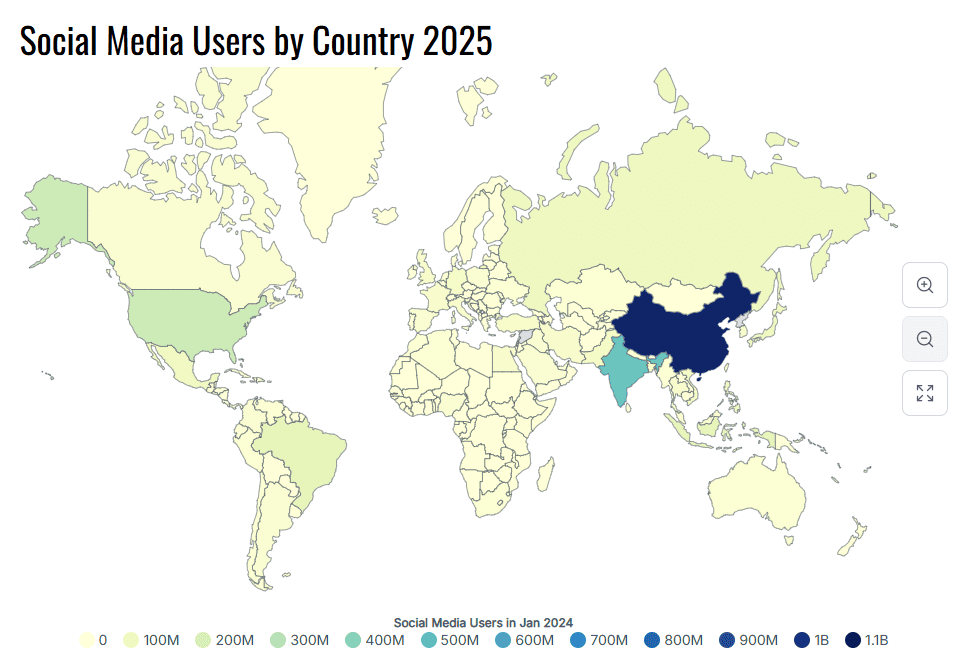
Social media users by country 2025
43. The United States has 239 million active social media users, one of the highest usage rates in the world. Again, Facebook is the most popular platform there, followed by Instagram and X.
44. Brazil has 144 million social media users, with WhatsApp being the most used platform, followed by Instagram and Facebook.
45. Indonesia has 139 million social media users, where WhatsApp is the most widely used platform with a very high penetration rate.
46. Russia has 106 million social media users, and Telegram is the most-used platform, followed by WhatsApp, VK, and TikTok.
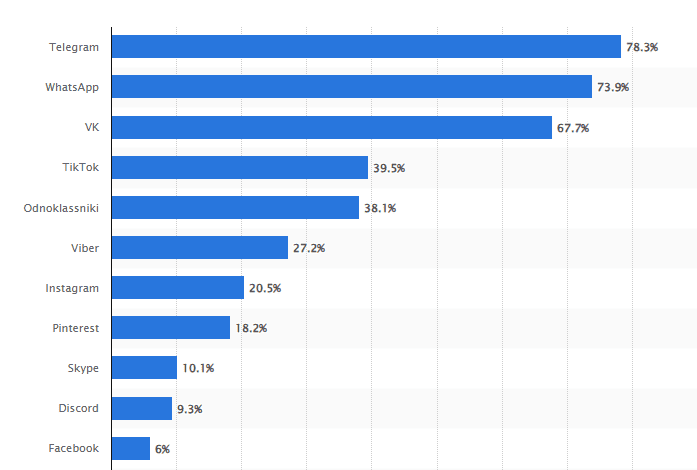
Leading social media platforms in Russia
47. Japan has 96 million social media users, where LINE is the most popular platform with 97 million users, followed by YouTube and X (formerly Twitter).
48. Mexico has 90.2 million social media users, and Facebook is the most used platform, closely followed by WhatsApp.
49. The Philippines has 86.8 million social media users, with Facebook being the dominant platform.
50. Vietnam has 72.7 million social media users, and Facebook is the most used platform, followed closely by Zalo, a local messaging app.
Top Social Media Platforms By Revenue
It’s not just about who has the most users—it’s about who’s making the most money. Some platforms are pulling in billions through ads, subscriptions, and premium features that keep the cash flowing.
But why does that matter to you?
Because revenue shows which platforms have cracked the code on making social media a money-making machine
Here are the top social media platforms stats that will reveal who’s cashing in online and where.
51. Facebook leads all platforms in revenue, earning $80.7 billion annually because of its massive user base and powerful ad system, even though it ranks only third in time spent.
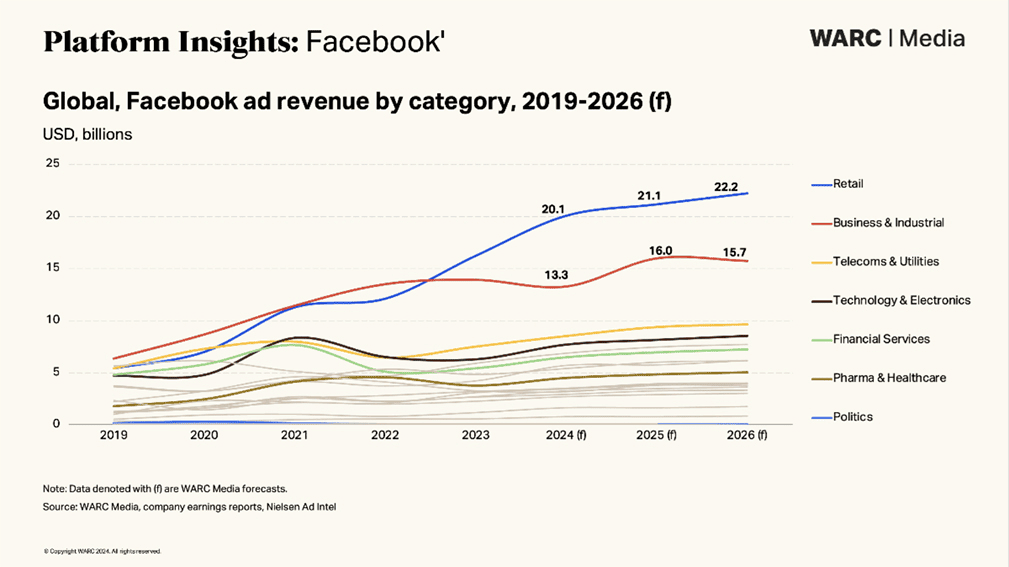
Facebook ad revenue by category
52. Instagram is the second-highest earner, bringing in $49.8 billion per year, driven by its strong presence in influencer marketing and e-commerce.
53. YouTube ranks third in annual revenue, generating $31.5 billion, with video ads playing a major role in its monetization.
54. WeChat and TikTok are nearly tied in revenue, with WeChat earning $16.3 billion and TikTok close behind at $16.1 billion.
55. LinkedIn brings in $15.7 billion annually, making it a top revenue platform despite users spending just 51 minutes per month, the lowest among major networks.
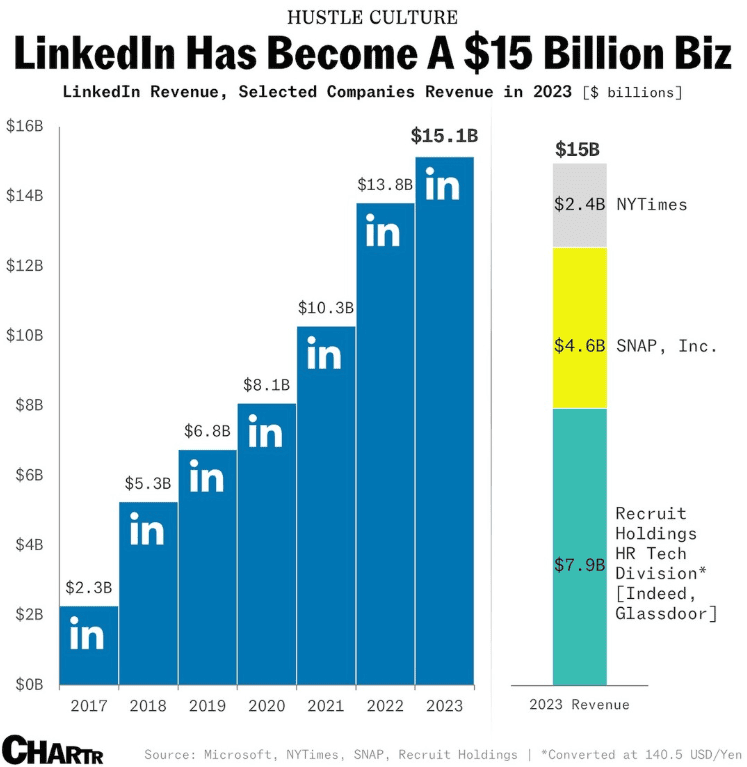
LinkedIn has crossed the 15 billion revenue mark
56. Snapchat generates $4.6 billion annually, showing strong ad performance among its younger user base.
57. X (formerly Twitter) earns $3.4 billion per year, putting it in the middle tier for revenue despite having 586 million users.
58. Pinterest makes $3.0 billion annually, performing well in shopping-related and discovery-based advertising, even with lower user time spent.
59. WhatsApp earns $1.2 billion a year, which is low compared to its 2 billion active users, highlighting the challenge of monetizing messaging apps.
60. Reddit brings in $800 million in annual revenue, despite a loyal and active community, showing limited monetization compared to other platforms.
61. Meta (which owns Facebook, Instagram, and WhatsApp) dominates overall revenue, earning a combined $131.7 billion annually across its platforms.
62. YouTube and TikTok show the strong earning potential of video-first platforms, as both are ranking in the top five for revenue.
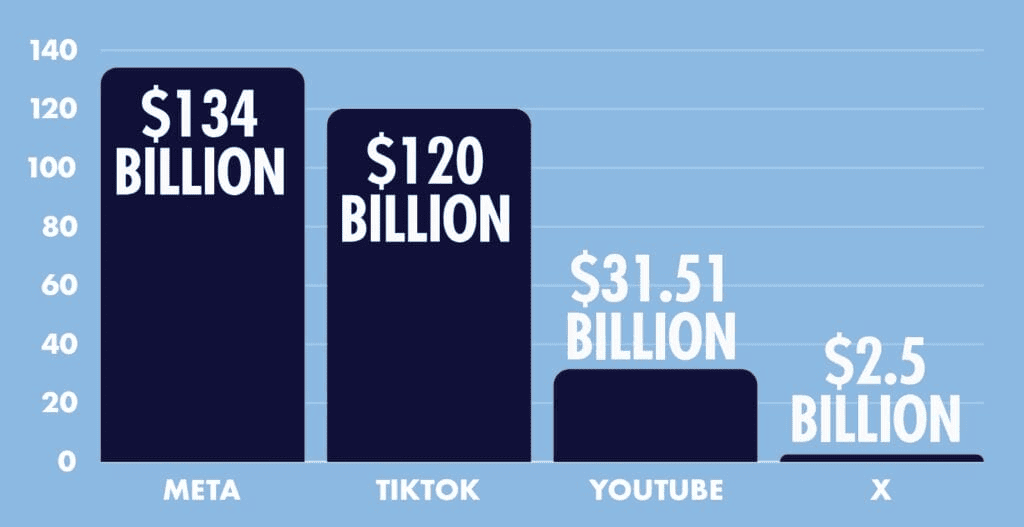
Social media platforms by revenue
63. LinkedIn stands out for high revenue per user, proving that niche platforms can succeed through premium features and targeted business ads.
64. Despite large audiences and high engagement, platforms like WhatsApp and Reddit earn significantly less. That’s because it’s harder to monetize messaging and community-based apps compared to ad-driven networks.
Top Social Media Platforms By Time Spent
How long people stick around on a platform says a lot about how hooked they really are.
Some apps keep users scrolling for hours with nonstop content, while others are just quick pit stops on a very busy day.
Time spent is a strong signal of loyalty, engagement, and even a bit of digital addiction.
The following top social media platforms stats will reveal where people are spending most of their digital lives.
65. TikTok ranks first in time spent, with users averaging 34 hours per month, nearly 6 hours more than YouTube.
66. YouTube users spend about 28 hours and 5 minutes per month on the platform, making it the second most engaging in terms of time spent.
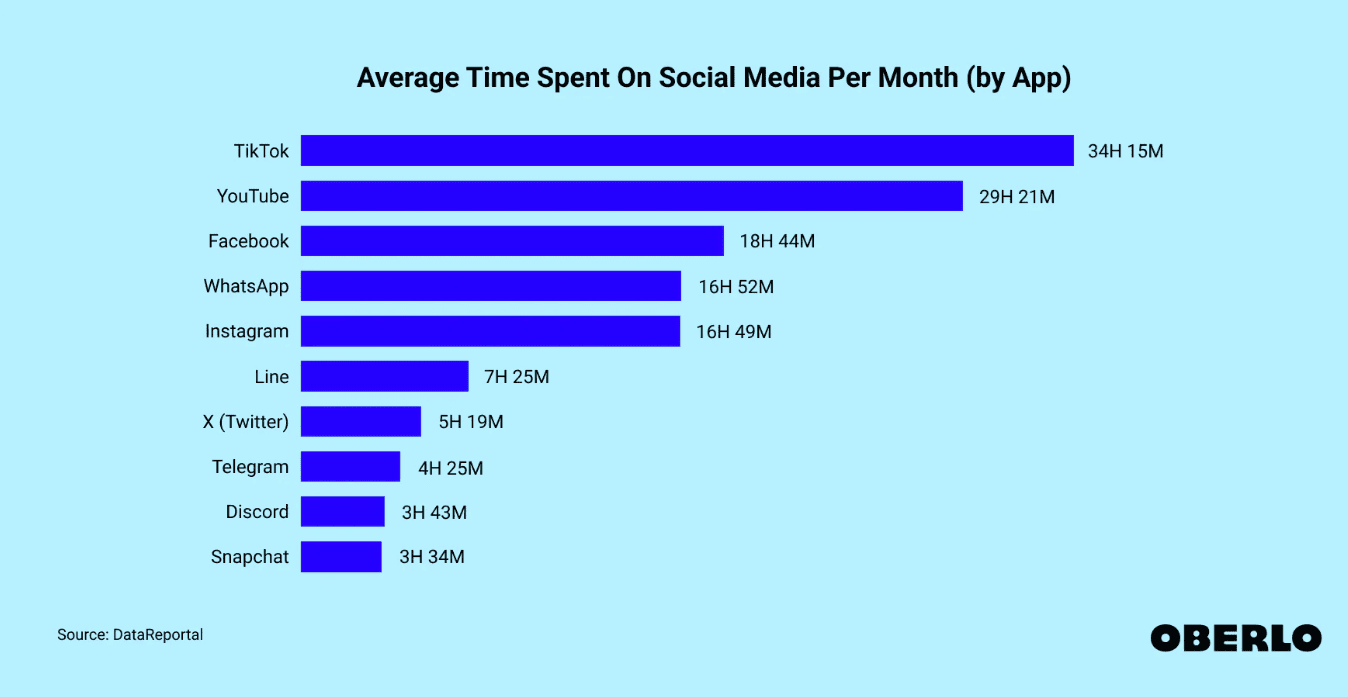
Average time spent on social media per month
67. Facebook comes in third, with users spending 19 hours and 47 minutes per month, despite having the largest number of users globally.
68. WhatsApp ranks fourth, with users spending an average of 17 hours and 6 minutes per month.
69. Instagram users spend about 15 hours and 50 minutes per month, slightly less than WhatsApp.
70. LINE, a messaging app popular in Japan and parts of Asia, sees 8 hours and 14 minutes of user engagement per month.
71. X (formerly Twitter) users average 4 hours and 40 minutes per month, placing it in the mid-to-lower range for engagement time.
72. Telegram users spend about 3 hours and 45 minutes per month, while Snapchat users follow closely at 3 hours and 33 minutes.
73. Facebook Messenger users average 3 hours and 21 minutes per month, significantly lower than its counterpart WhatsApp.
74. Pinterest users spend around 1 hour and 49 minutes per month.
75. LinkedIn sees the least time spent, with users averaging just 51 minutes per month.
Conclusion
That wraps up our breakdown of the top social media platform stats.
Major players like Facebook, YouTube, and Instagram continue to lead in users and revenue.
Still, platforms like TikTok, Telegram, and Snapchat are capturing more user time and attention, especially among younger audiences.
Short-form video, private messaging, and regional apps like WeChat and LINE are shaping the way people connect in 2025, making it clear that social media is evolving faster than ever.


